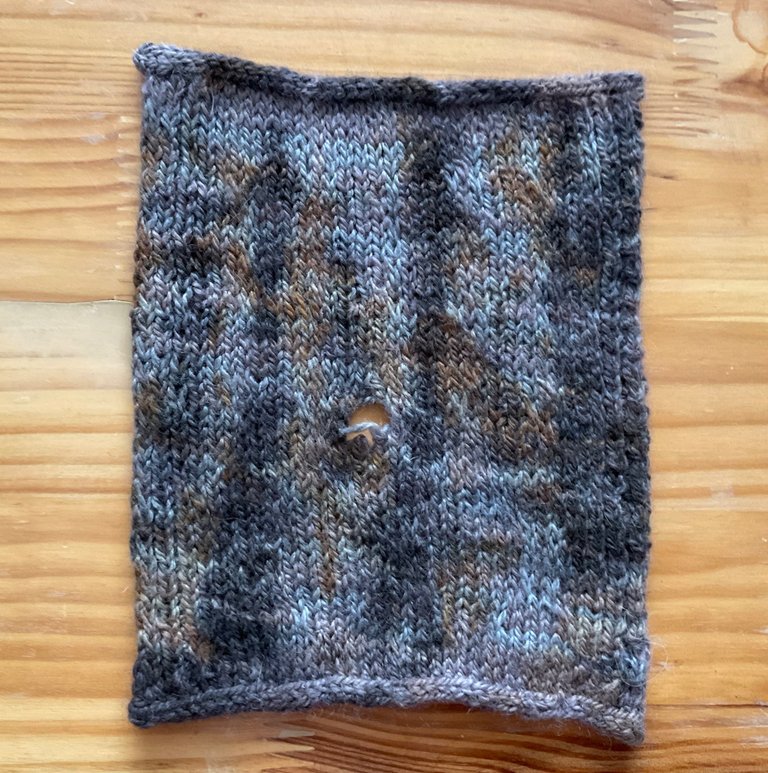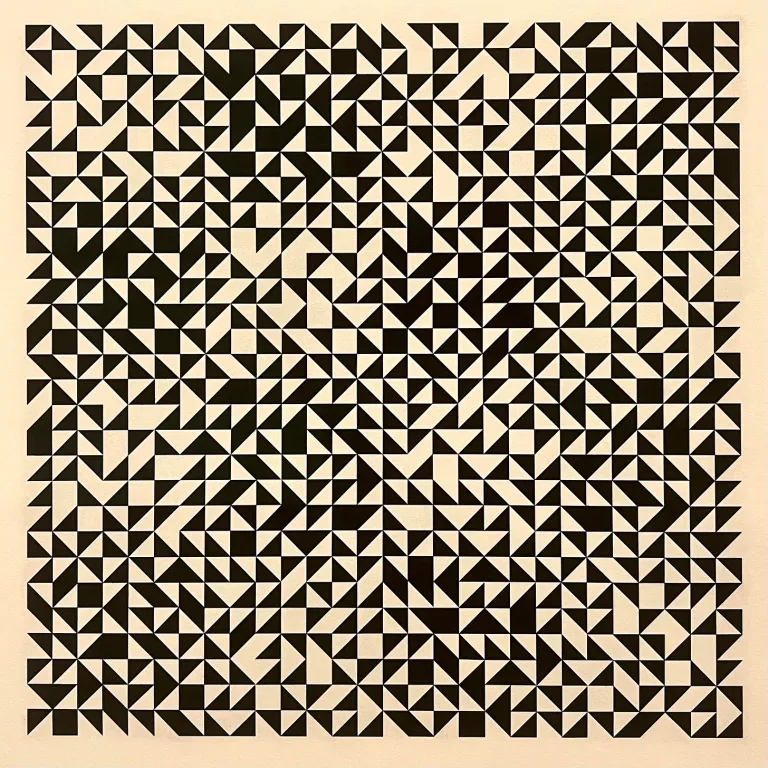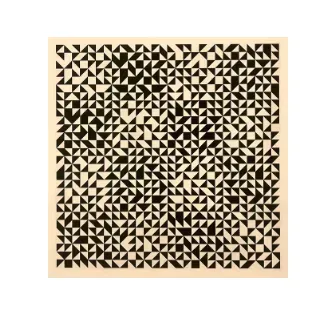
a small sample for my design notebook to test out ideas.
Influences
1992, the 500th anniversary of Columbus' journey across the Atlantic to the Americas, was the prompt.
1492 seemed to mark, for the European world, a change between ages, from the old Middle Ages enlightened by the Renaissance, to modernity. The Atlantic journey seemed portentous, foreshadowing the many trans-Atlantic journeys that followed, transporting riches, trafficking people.
Later, I was fascinated with Inca stripes, diamond squares and chevrons, the complex symbolism in their architecture. Other images that came to my mind were the triangular engravings, prints and textiles of Anni Albers.

Source Second Movement 1, 1978, Anni Albers - close view

Source Second Movement 1, 1978, Anni Albers - distant view
Both images are from Anni Albers and her triangle era, 2024, by Stacey Taylor, who was inspired by the ideas of creating illusions of movement and designs that look random and more ordered depending on your viewpoint of Albers' work.
Me, I started with trying a small block of mosaic knitting, the angles and shapes reminding me of Albers and Inca designs. I chose two closely matching colours, so sometimes you see both and sometimes, depending on the light, they merge together. The first finished block was distorted with the uneven colour work. I blocked it but afterwards regretted it, because I liked the textured patterns created by the stitches.
For a long time I wondered how to take forward my ideas, how to bring in my thoughts about those trans-Atlantic crossings. I removed some duplicate stitch that hadn't worked, snipping a stitch inadvertently in the process. I liked that little piece of damage, a slight fraying. Then I came across slow stitching:
... simply taking a piece of fabric, needle and thread and using simple stitch marks upon the textile. Going with the flow of your fabric, your mind, your thought process. There is no set pattern to follow, no embroidery lines to mark up. Instead you learn to listen to your innate sense of creativity and allow your hands to flow across the fabric. Source
and along with it, eco-dyeing and printing, using tea bags (used and not), onion skins, rust and other natural phenomena. I've been following a blogger, her work is very interesting, but I find myself repelled and attracted in equal measure by her work.
I love the care of cloth and stitches, the bond with nature, the valuing of "precious scraps", the focus on sustainability, re-using and re-purposing. But I am repelled by the accumulation of materials and bits and pieces, the lingering over old lace and linen and more than anything, the murky tea and rust dyed fabrics that remind me of mummies and winding cloths.
But perhaps this is what I needed for 1992, how to represent decay, disease, squalor, privation.
Techniques
I tried the rust dyeing, easily done with items you'll have in your house: metal screws and bolts, chains, nails and washers. I thought I had a mangled piece of rusted iron in the garden, long and narrow, but I could only find an old drainpipe and the footing for scaffolding. They do not have to be rusty before you start.
Every method started by spraying the cloth with a 50/50 mixture of water and vinegar, laying on the metal pieces and then gathering up the cloth and binding tightly to ensure contact with the metal. Then followed different options: steam for three hours over water, or leave wrapped in a plastic bag for two days. Other options included burying in the ground or hanging up outside to get weathered, or maybe leaving under water. The time for these seemed to vary between one and three months, with longer in the winter. I put my plastic wrapped, vinegar-soaked cloth on the radiator as it was January, and left it for twenty-four hours.
This was long enough, great crude rust marks were left on the cloth, which I rinsed and left in a salt solution for several hours. This stops the rust reaction. After rinsing again, I folded the scrap into a concertina and wrapped with parcel string, before immersing in a strong tea solution, left to brew for an hour before the (used) tea-bags were removed. I left it for an hour or two before unravelling the scrap and rinsing thoroughly and laying out to dry.
I liked the final result - the dark, almost black colouration was caused by the rust reacting with the tannins in the tea solution. It softened the crudity of the rust patterns and created a layered effect. It was still possible to see the base mosaic patterns, echoing the Mayan architecture, and the pale blue and mauve colours of the yarn, chosen so that, depending on the light, sometimes you would see them and sometimes they would merge.
The fabric had the worn and weathered appearance I was aiming for and a depth that suggested many lives and experiences. It was still soft and flexible with a subtle patina and the stitches had begun to become more uniform as knitting does over time. A hole had started to appear where I had nicked the stitch during the manipulation of the fabric but it hadn't unravelled. I also especially liked the fine lines crossing the dark patches where the string had been tied.
Materials and Sources
Knitted in Rowan Island Blend Fine - 70% wool, 15% silk, 15% alpaca.
Colours: Regalia and Wedgwood; 3.25mm fixed circular Knitpro Symfonie needles.
Knitted in stocking stitch (mosaic) with ribbed borders (R/S: sl1,k1,p1,k1,p1 - p1,k1,p1,k2; W/S: sl1,p1,k1,p1,k1 - k1,p1,k1,p1,k1). Cast on/off - i-cord edge.
Mosiac Knitting Workshop, 2023, by Ashleigh Wemple, David & Charles.
Christopher Columbus - context and transatlantic journeys.
I love this ! The way the blues, greys and browns blend with each other and have a similar tonal intensity really works.
Oh, and 1492 is a myth... as was proven when the US did the 400th anniversary celebration of Columbus' landing in 1892 and the Norwegians had build a longship which rowed across the North Atlantic and turned up unannounced in Boston harbour during the event 😁 So Lucky Leif got there first. Or maybe second after St Brendan, or third after the Carthaginians...... although the locals were there making beautiful art all along, of course.....
Oh yes, I've heard stories about the Norsemen but not the Cathaginians although both make perfect sense. St Brendan is new to me I shall have to look him up. It's more the terrible damage that came after Columbus that came to my mind.
Glad you liked the experiment 🙂
They found the first Viking settlement at L'Anse Aux Meadows in Newfoundland a few years ago, with evidence that they at least gathered foodstuffs further south although I don't think they've found any other definite settlements yet.
As for the Carthaginians, that's one of those "did they/didn't they" questions. They were great navigators. Their ancestors the Phoenicians travelled to the Cassiterides, which may have been Cornwall or the Scilly Isles, and Hanno of Carthage claimed to have circumnavigated Africa. Their ships were seaworthy enough that they could (just !) have made the journey, but the Romans took their remaining records in 146BC, after which everything gets a bit murky.